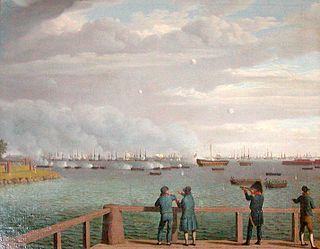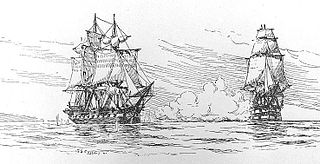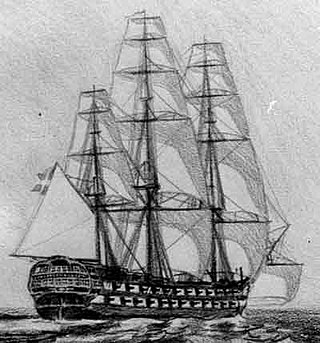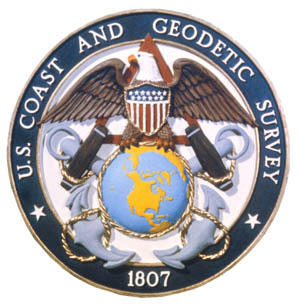USS Franklin may refer to:

The Second Battle of Copenhagen was a British bombardment of the Danish capital, Copenhagen, in order to capture or destroy the Dano-Norwegian fleet during the Napoleonic Wars. The incident led to the outbreak of the Anglo-Russian War of 1807, which ended with the Treaty of Örebro in 1812. The attack on Denmark, a neutral country, was heavily criticized internationally.

HMS Leopard was a 50-gun Portland-class fourth rate of the Royal Navy. She served during the French Revolutionary and Napoleonic Wars, and was notable for the actions of her captain in 1807, which were emblematic of the tensions that later erupted in the War of 1812 between Britain and America. She was wrecked in 1814.

The Blockade of Africa began in 1808 after the United Kingdom outlawed the Atlantic slave trade, making it illegal for British ships to transport slaves. The Royal Navy immediately established a presence off Africa to enforce the ban, called the West Africa Squadron. Although the ban initially applied only to British ships, Britain negotiated treaties with other countries to give the Royal Navy the right to intercept and search their ships for slaves.

Holsteen was a 60-gun ship of the line in the Royal Dano-Norwegian Navy. She was commissioned in 1775 and the British Royal Navy captured her in the Battle at Copenhagen Roads on 2 April 1801. The British renamed the ship HMS Holstein, and later HMS Nassau. She participated in one major battle during the Gunboat War and was sold in 1814.
Three Royal Navy ships have been called HMS Egeria:
Five ships and three shore establishments of the Royal Navy have borne the name HMS Caledonia after the Latin name for Scotland:
Four ships and three shore establishments of the Royal Navy have been named HMS Sultan.

The United States Coast and Geodetic Survey, known from 1807 to 1836 as the Survey of the Coast and from 1836 until 1878 as the United States Coast Survey, was the first scientific agency of the United States Government. It existed from 1807 to 1970, and throughout its history was responsible for mapping and charting the coast of the United States, and later the coasts of U.S. territories. In 1871, it gained the additional responsibility of surveying the interior of the United States and geodesy became a more important part of its work, leading to it being renamed the U.S. Coast and Geodetic Survey in 1878.
USRC Gallatin was the name of more than one ship of the United States Revenue Cutter Service:

HMS Leveret was a Cruizer-class brig-sloop built at Dover, England, and launched in 1806. She was wrecked in 1807.
Wanstead was launched in 1802. In 1807 a French privateer captured her, but the British Royal Navy recaptured her the next day. Then in 1810 she was again captured by a French privateer, and was again recaptured a few days later. In 1819 she traded with India or China under a license from the British East India Company (EIC). She was wrecked in 1820.

Henrik Gerner (1742–1787) was a Danish naval officer who specialised in shipbuilding and naval architecture. His interests as an entrepreneurial engineer led to unsinkable gun platforms, horse-driven dredging machines, and desalination equipment for Orient-bound trading ships.
HDMS Delphinen was a brig of the Royal Dano-Norwegian Navy, launched in 1805 at Nyholm. The British Royal Navy captured her in 1807 at the Danish surrender after the Battle of Copenhagen. The Royal Navy commissioned her in 1808 as HMS Dolphinen but she was already lost later that year.

Frantz Christopher Henrik Hohlenberg was a Danish naval officer who specialised in ship design and had little seagoing experience. He succeeded Ernst Wilhelm Stibolt as Master Shipbuilder (fabriksmester) at the Royal Danish Dockyards in 1796. His ships included five ships of the line and 18 frigates. Three of the ships of the line and nine of the frigates were captured at the 1807 Battle of Copenhagen and subsequently added to the Royal Navy. He resigned after a controversy in 1803.







